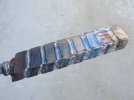- Joined
- Dec 3, 1999
- Messages
- 9,437
So the last several tiled mosaic billets I've done, I've forge welded inside of a "box/canister" made out of mild steel.
Normally I tack weld the 45 degree cut pieces on the outside edges, then wrap in SS foil, then build a "box" around it and weld around completely. It's a bit of PITA, but all of the billets have come out SUPER clean... you wouldn't even know where the weld line is if it weren't for the pattern shift.
So this week I put one together but had the bright idea to superglue the tiles together instead of tack welding them. That is THE ONLY thing I did differently.... but after forging and removing the box....there is a very distinct, thin silver line between the tiles. If I hadn't done all the work on it myself, you'd have a hard time convincing me that the lines aren't pieces of pure nickel between each tile. :foot:
:foot:
Any of you guys have this happen? Any ideas here???
Oh, and the tiles were all milled flat and surface ground so they fit together TIGHT AND FLAT before building the box/forge welding.
THANKS!!!
Normally I tack weld the 45 degree cut pieces on the outside edges, then wrap in SS foil, then build a "box" around it and weld around completely. It's a bit of PITA, but all of the billets have come out SUPER clean... you wouldn't even know where the weld line is if it weren't for the pattern shift.
So this week I put one together but had the bright idea to superglue the tiles together instead of tack welding them. That is THE ONLY thing I did differently.... but after forging and removing the box....there is a very distinct, thin silver line between the tiles. If I hadn't done all the work on it myself, you'd have a hard time convincing me that the lines aren't pieces of pure nickel between each tile.
Any of you guys have this happen? Any ideas here???
Oh, and the tiles were all milled flat and surface ground so they fit together TIGHT AND FLAT before building the box/forge welding.
THANKS!!!





